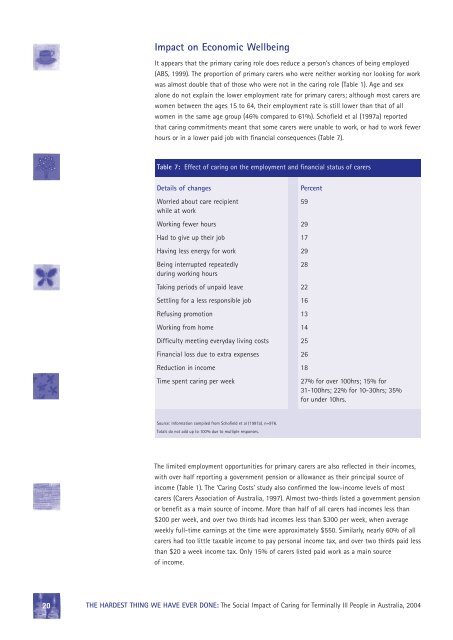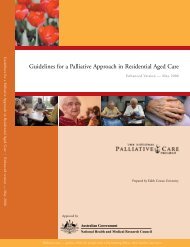The hardest thing we have ever done - Palliative Care Australia
The hardest thing we have ever done - Palliative Care Australia
The hardest thing we have ever done - Palliative Care Australia
You also want an ePaper? Increase the reach of your titles
YUMPU automatically turns print PDFs into web optimized ePapers that Google loves.
Impact on Economic Wellbeing<br />
It appears that the primary caring role does reduce a person’s chances of being employed<br />
(ABS, 1999). <strong>The</strong> proportion of primary carers who <strong>we</strong>re neither working nor looking for work<br />
was almost double that of those who <strong>we</strong>re not in the caring role (Table 1). Age and sex<br />
alone do not explain the lo<strong>we</strong>r employment rate for primary carers; although most carers are<br />
women bet<strong>we</strong>en the ages 15 to 64, their employment rate is still lo<strong>we</strong>r than that of all<br />
women in the same age group (46% compared to 61%). Schofield et al (1997a) reported<br />
that caring commitments meant that some carers <strong>we</strong>re unable to work, or had to work fe<strong>we</strong>r<br />
hours or in a lo<strong>we</strong>r paid job with financial consequences (Table 7).<br />
Table 7: Effect of caring on the employment and financial status of carers<br />
Details of changes<br />
Worried about care recipient<br />
while at work<br />
Working fe<strong>we</strong>r hours<br />
Had to give up their job<br />
Having less energy for work<br />
Being interrupted repeatedly<br />
during working hours<br />
Taking periods of unpaid leave<br />
Settling for a less responsible job<br />
Refusing promotion<br />
Working from home<br />
Difficulty meeting <strong>ever</strong>yday living costs<br />
Financial loss due to extra expenses<br />
Reduction in income<br />
Time spent caring per <strong>we</strong>ek<br />
Percent<br />
59<br />
29<br />
17<br />
29<br />
28<br />
22<br />
16<br />
13<br />
14<br />
25<br />
26<br />
18<br />
27% for over 100hrs; 15% for<br />
31-100hrs; 22% for 10-30hrs; 35%<br />
for under 10hrs.<br />
Source: Information compiled from Schofield et al (1997a). n=976.<br />
Totals do not add up to 100% due to multiple responses.<br />
<strong>The</strong> limited employment opportunities for primary carers are also reflected in their incomes,<br />
with over half reporting a government pension or allowance as their principal source of<br />
income (Table 1). <strong>The</strong> ‘Caring Costs’ study also confirmed the low-income levels of most<br />
carers (<strong>Care</strong>rs Association of <strong>Australia</strong>, 1997). Almost two-thirds listed a government pension<br />
or benefit as a main source of income. More than half of all carers had incomes less than<br />
$200 per <strong>we</strong>ek, and over two thirds had incomes less than $300 per <strong>we</strong>ek, when average<br />
<strong>we</strong>ekly full-time earnings at the time <strong>we</strong>re approximately $550. Similarly, nearly 60% of all<br />
carers had too little taxable income to pay personal income tax, and over two thirds paid less<br />
than $20 a <strong>we</strong>ek income tax. Only 15% of carers listed paid work as a main source<br />
of income.<br />
20 THE HARDEST THING WE HAVE EVER DONE: <strong>The</strong> Social Impact of Caring for Terminally Ill People in <strong>Australia</strong>, 2004
















